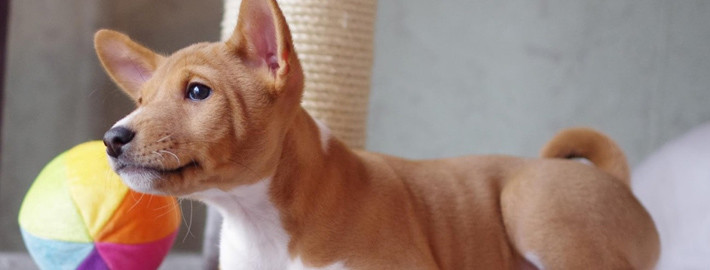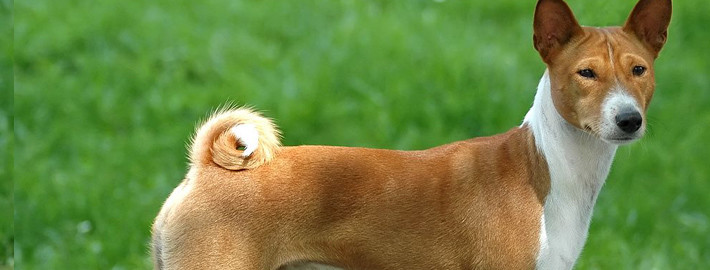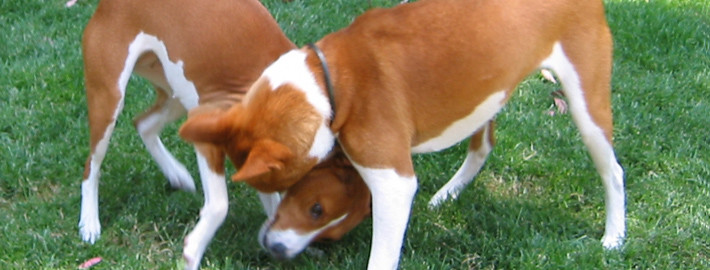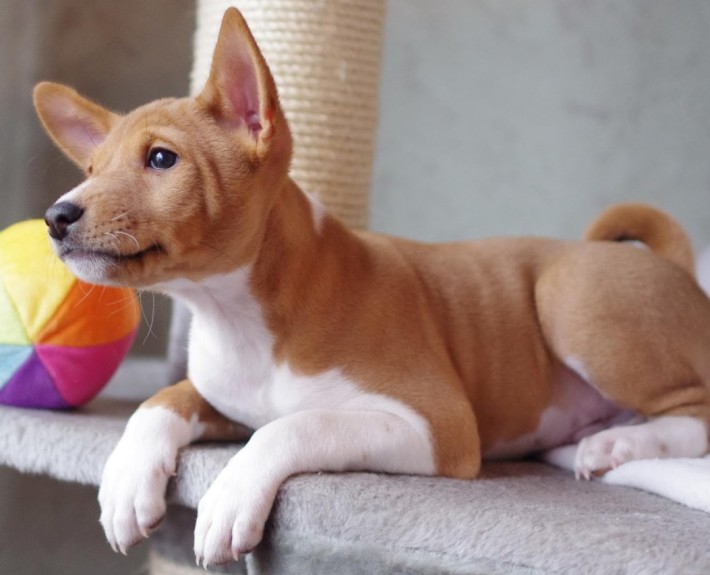What makes the Basenji Unique?
For a spirited hunting dog or a family-friendly watchdog, prospective owners should look no further than this historical breed. For many thousands of years, the Basenjis’ ancestors hunted game on the African savannah and guarded their human families with a watchful eye. It goes without saying that their modern-day descendants follow closely in their pawprints.
Page Contents
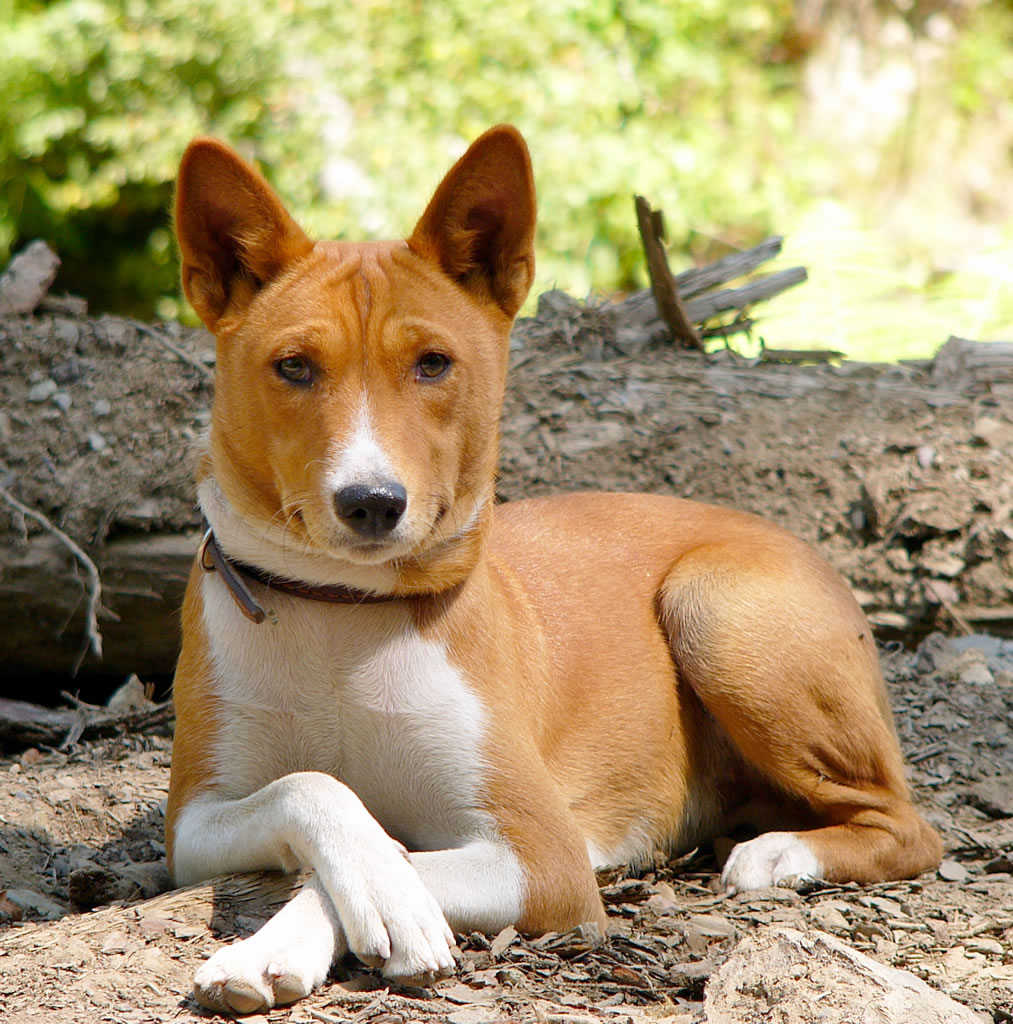
SnapShot
| Size: | Males – 41 to 43 cm (16 to 17 inches) Females – 38 to 41 cm (15 to 16 inches) |
| Weight: | Males – 10 to 12 kg (22 to 26.5 pounds) Females – 9 to 11 kg (19.8 to 24.3 pounds) |
| Origin: | Congo |
| Life Span: | 12 – 16 Years |
| Colour: | Red, Tri-color, Brindle, Black & White, Tan, Black |
| Litter Size: | 4 to 6 puppies |
Is the Basenji Right For You?
The owner of the first Basenji shown at the leading London dog show, Crufts, named them ‘Basenji’ after an African word meaning ‘bush thing’. Dogs similar to Basenjis can probably still be found in Africa, where native hunters traditionally used them to flush out small game, guided by the sound of a rattle (a gourd containing small stones) tied around the dog’s neck. Basenji is a terrier-like mannerisms because it is feisty for a hound. More often it is considered catlike in mannerisms: clever, inquisitive, stubborn, independent and reserved. Its hunting roots are very evident, as it loves to chase and trail. It needs regular mental and physical stimulation, lest it become frustrated and destructive.
In 5 Words
- Playful
- Alert
- Curious
- Energetic
- Intelligent
Characteristics
Learn About the Basenji
General Description
Basenjis are squarely proportioned, muscular dogs. This breed has long, straight legs that enable them to run quickly to catch prey. They also have small, erect ears that are open in the front. This feature proved useful in hunting for small game in the tall bush. These dogs have wrinkled foreheads and muzzles that are shorter than their flat skulls. Basenjis have almond-shaped eyes that range in color from dark hazel to dark brown. Their level backs have a high set tail that is carried curled over to one side.
Size
Basenji males should ideally measure about 16 to 17 inches (41 to 43 centimeters) in height and weight between 22 and 26 pounds (10 to 12 kilograms). Females of this breed should weigh between 20 and 25 pounds (9 and 11 kilograms) and measure 15 to 16 inches (38 to 41 centimeters) in height.
Coat
Basenjis were bred to have a short, fine coat as this would help keep them cool in the warm African climate. Their fur comes in pure black, copper, red, chestnut red, and tricolor. Combinations of black, tan and white, or black, brindle and white are the available tricolor types. White areas on the feet, chest, and tail are specified by AKC breed standards. These dogs may also have white patches on their legs as well as their blaze and collar areas.
Short History of the Basenji
Basenjis were originally bred to flush out small game. Egyptian tombs dating as far back as five thousand years ago are thought to depict a variety of dog that is very similar to its modern day counterparts. Though that distinction may apply to other types of canines as well, Basenjis are nonetheless thought to have one of the oldest dog lineages in the world. They are also featured in a number of cave paintings found in Libya that were dated somewhere between 6000 BC and 100 AD.
The most recent description that can reliably be verified as being an actual Basenji dates back to 1868, when explorer Dr. Schweinfurth encountered them in Africa. The owner of the first dog that was shown at London’s Crufts Dog Show named the breed “Basenji”, which is a loose translation of an African term meaning “bush thing”. Also known as the Congo Dog, the Basenji was successfully introduced in England by the late 1930s and by the 1940s had reached the United States as well. The American Kennel Club (AKC) recognized the breed in 1944. Basenjis are currently classed as members of the Hound group.
Temperament
With regular handling and proper socialization from a young age Basenjis will make good pets. They are good with other pets if raised around them, but otherwise issue may arise. This reserved breed is additionally wary of strangers but they will form strong, affectionate bonds with their human families. These dogs are best suited to households with older children because Basenji can be a bit headstrong and tend to need strong leadership if they are not to view themselves as the one in charge. Although members of this breed do not bark, they nonetheless can make themselves heard and they are known for their yodeling type howls. Depending on their mood, these dogs can emit a variety of other sounds.
These dogs are certainly are intelligent but they are also inquisitive. Therefore, Basenjis may decide to investigate the garbage or sample things that owners might prefer they didn’t such as electronic devices or furniture. They also enjoy chewing on things and owners are advised to purchase plenty of chew toys rather than risk having their belongings destroyed. Even so, there may be some collateral damage of possessions from time to time.
Caring for Your Basenji
General Health
Born in litters of four to six puppies, Basenjis live about twelve years in good health. Especially in America, the breed is afflicted by a kidney disorder called Fanconi Syndrome, which can be identified by excessive drinking and urination. Other problems include haemolytic anaemia, hypothyroidism, progressive retinal atrophy, and hip dysplasia as well as disorders of the intestines or the eyes. On a more minor note, Basenjis do not like wet or cold weather and should be either brought indoors when inclement weather strikes or be kept somewhere that it is warm and dry
Grooming & Bathing
Bathing is not required for this breed, because these dogs regularly groom themselves in the same manner that cats do. Owners will still need to trim their Basenji’s toenails and clean out it’s ears on a regular basis.
Daily
These highly energetic dogs need both mental stimulation and plentiful exercise to prevent them from indulging in destructive behaviors. Basenjis will certainly benefit from being allowed to play in a fenced enclosure for extensive periods of time. However, this breed is well-known for their abilities as escape artists. They are amazing jumpers and can easily climb chain length fences. Therefore, owners are advised to keep a watchful eye on their pets.
Weekly
Grooming these dogs once or twice weekly with a coarse rubber brush to remove dead hairs is recommended. It is also a good idea to brush their teeth regularly in order to prevent disease.
Monthly
As with any breed, administering flea, tick and heartworm prevention medication on a monthly basis is recommended.
Exercise & Training
Although they are known for being a relatively quiet breed, Basenjis remain very active dogs that require copious amounts of exercise. Prospective owners that wrong equate the breed’s silence with inactivity will certainly receive an unpleasant surprise, but those who tailor their expectations accordingly will be pleased with their dogs. In fact, Basenjis that spend a great deal of time playing with the children in their family may end up worn out with no further assistance and the same could be said for the kids
However, this charming and clever breed may convince the children to do what it wants rather than the other way around. A Basenji needs an adult leader who maintains consistent rules and shows natural authority in order to get it to obey. Those living with meek or passive owners may become convinced they are the alpha dog and this paves the way for destructive behaviors. It is also a good idea to enroll Basenjis in dog training classes so that they learn how to behave properly around other people and animals, rather than viewing them as something that should be avoided.
Sources: Previously written material, Wikipedia, Dog Breed’s Info, VetStreet, Basenji Club Online, AKC online,

